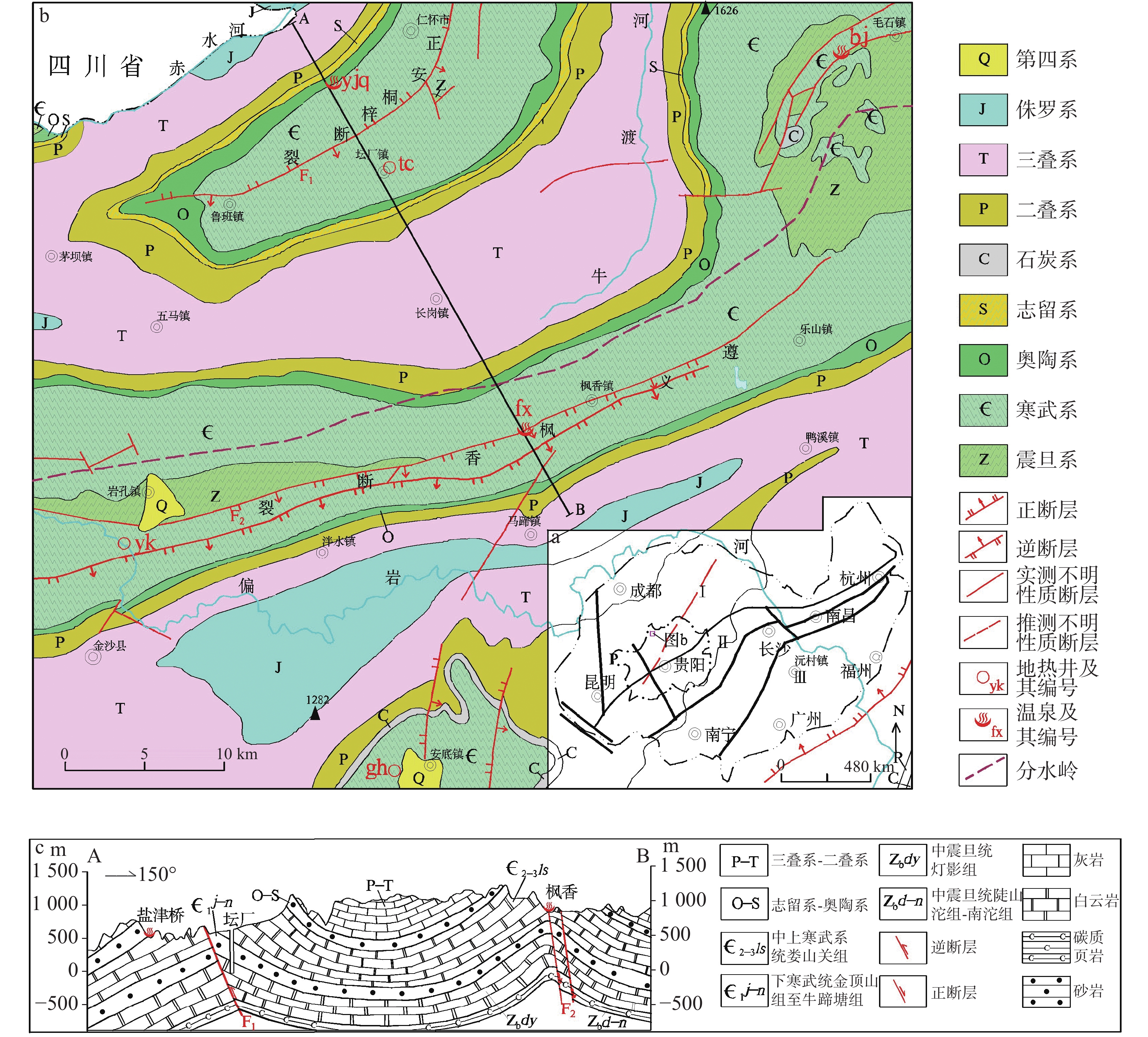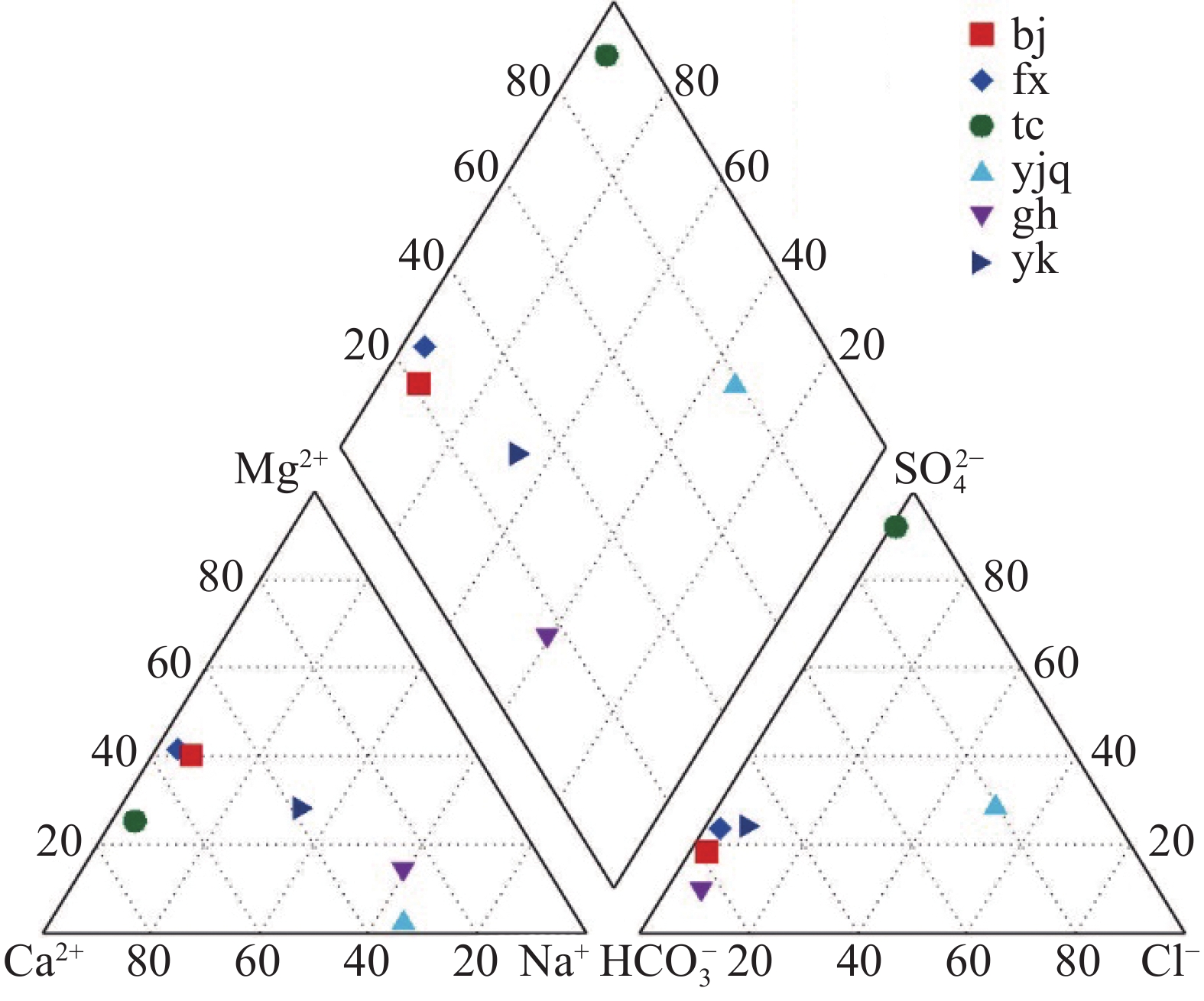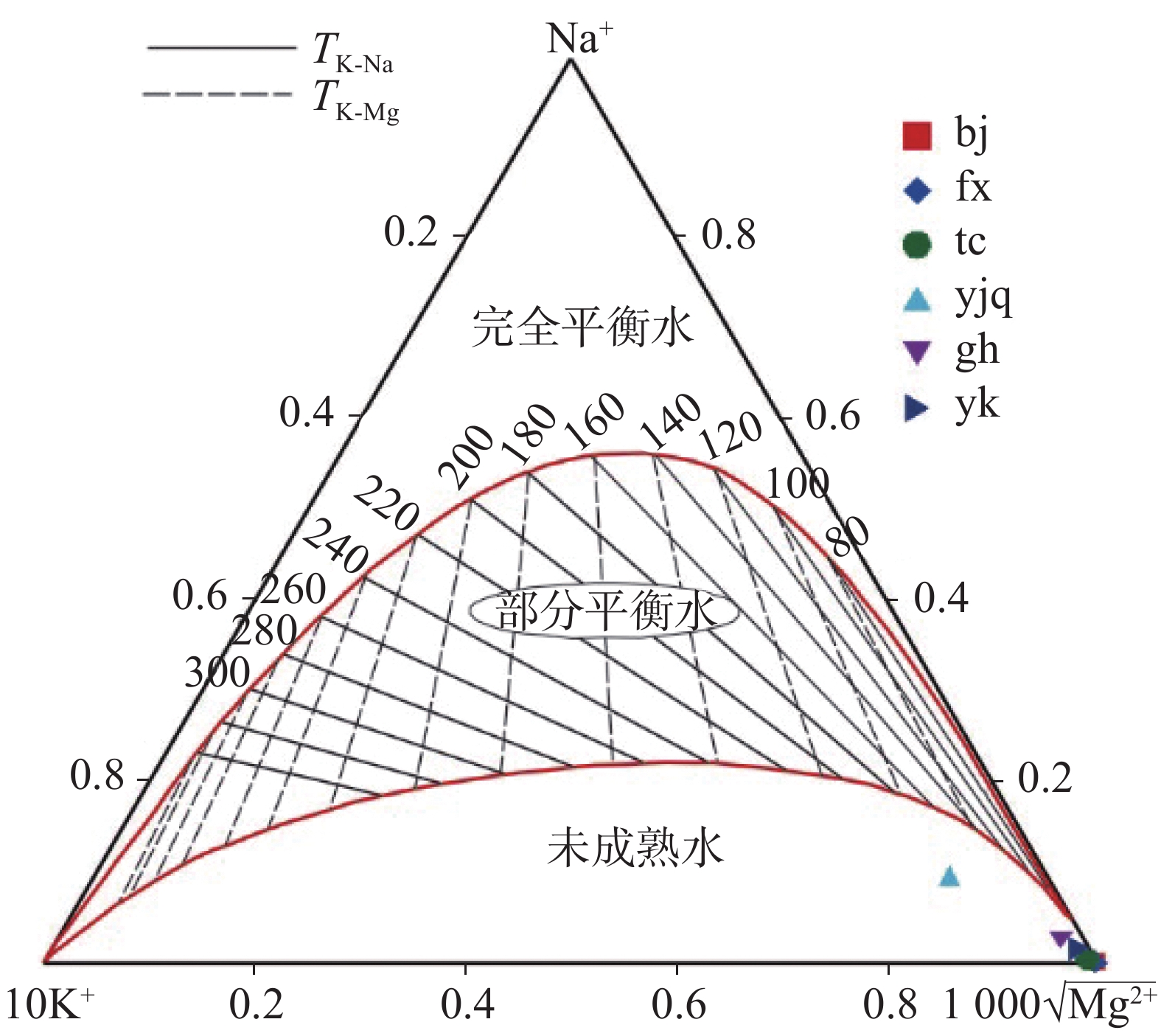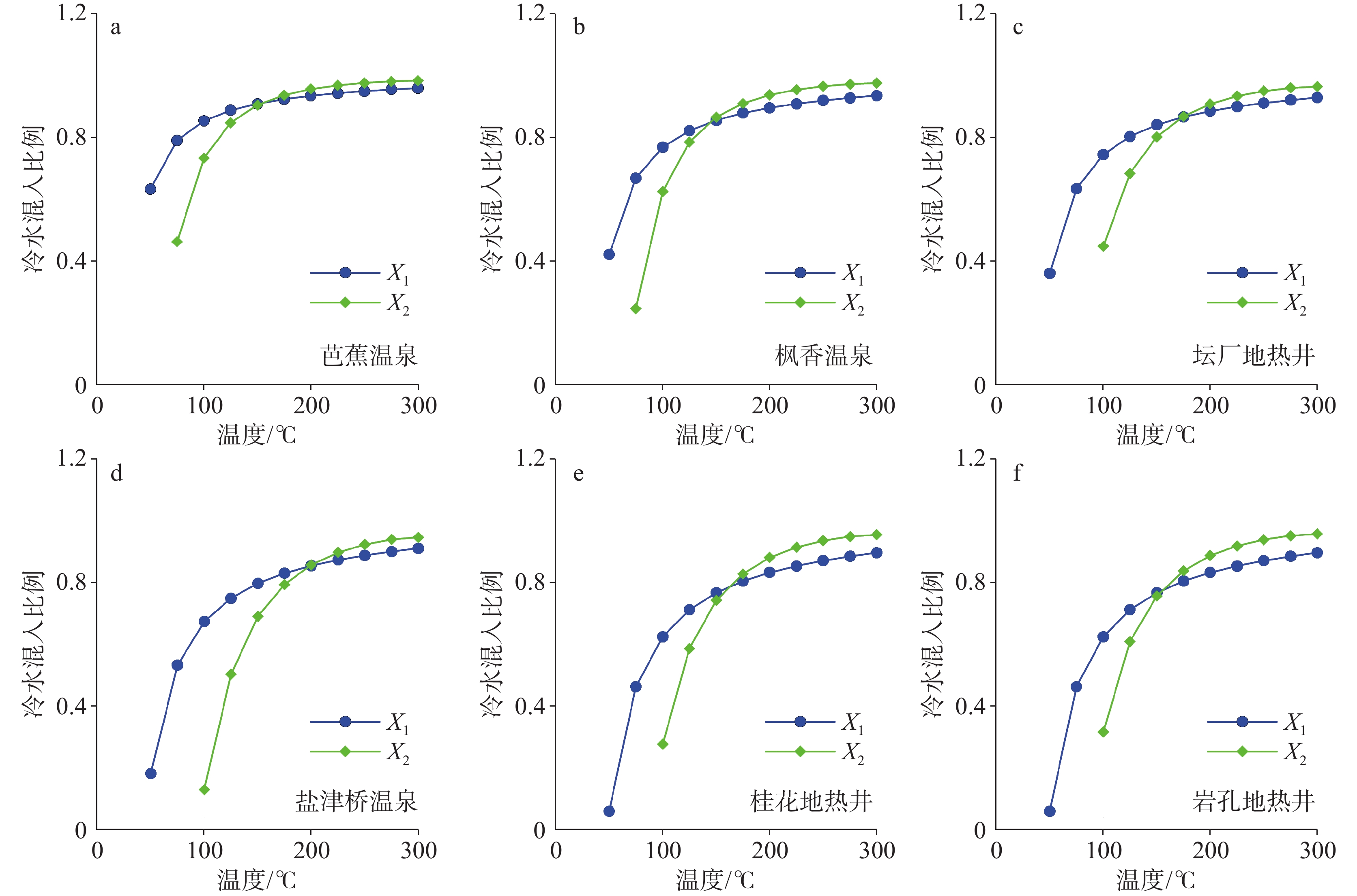Hydrochemical characteristics and genesis of geothermal water in the Zunyi area, north Guizhou
-
摘要:
黔北遵义地区地热资源丰富,但研究程度低,成因机制不明,制约了区内地热资源的合理开发利用。文章以遵义地区天然温泉和地热井为研究对象,采集了6组地热水样进行水化学组分、氢氧同位素分析,探讨了该地区地热水的成因。结果表明:研究区地热水水化学类型为SO4-Ca·Mg、Cl·SO4-Na·Ca、HCO3-Ca·Mg、HCO3-Na·Ca及HCO3-Ca·Na·Mg型,有益元素主要有Sr、Li、H2SiO3、F。地热水中的Ca2+、Mg2+、${\rm{HCO}}_3^{-}$主要来源于白云石、方解石的溶解;盐津桥和坛厂地热水中的Ca2+,除来自于白云石、方解石的溶解外,可能有富石膏白云岩或膏盐层中石膏溶解产生的Ca2+加入;地热水中${\rm{SO}}_4^{2-}$离子主要来源于石膏的溶解。四川含盐盆地古卤水的注入导致盐津桥地热水富Na+、K+、Cl−。地热水的补给来源为大气降水,补给区位于研究区中部的大娄山一带,补给高程为1 310.0~1 391.2 m,补给区年平均气温为4.4~8.3 ℃。利用二氧化硅温标估算的热储温度为53~95 ℃,地热水循环深度为1 372~2 633 m。硅−焓模型估算的地热水冷水混入比例为76%~92%。区内地下水在大娄山区接受大气降水入渗补给,经深循环并受深部热流加热后,沿导水断裂上升至地表,形成天然低温温泉,或在背斜核部断裂带附近经人工钻探形成地热井。
Abstract:The Zunyi area in north Guizhou is located on the slope section transiting from the Yunnan-Guizhou Plateau to the Sichuan Basin. This area is geotectonically situated on the southwestern margin of the Yangzi plate, where Neoproterozoic strata to Cenozoic strata are exposed with the absence of Devonian and Cretaceous strata. Tectonically, the "Jurassic folds", developed and distributed in the NE or NNE directions, consist of alternating anticlinoria and synclinoria. Fracture structures are mostly distributed in the core of anticlines, spreading in the NE–SW direction or near SN direction. The study area is at normal geothermal temperature gradient and within the regional heat flow value. This area is rich in geothermal resources at low-medium temperature, and its hot springs (wells) are distributed near the fracture zones of anticlines. The thermal reservoirs in this area are mainly composed of dolomite of Cambrian Loushanguan Group and Sinian Dengying Formation.
Generally, the insufficient research and unknown causal mechanisms have restricted the rational development and utilization of geothermal resources in this area. This study takes three hot springs and three geothermal wells distributed in the Zunyi area as research objects. Combining the regional geothermal geological data with the analysis of hydrochemical components and H-O isotope compositions of geothermal water, we explore the geothermal water source, the water-rock reaction process, and the elevation and temperature of recharge, calculate the thermal storage temperature, hot and cold water mixing ratio and thermal cycle depth, and summarize the genesis model of geothermal water, so as to provide a basis for the exploration, development and utilization of geothermal water resources in this area.
The results show that the temperature of geothermal water is 29–48 ℃; the pH value is 7.30–7.95; the TDS is 187.95–2,322.74 mg·L−1, the δD and δ18O are −72.1‰ to −50.0‰ and −11.03‰ to −8.23‰, respectively. Hydrochemically, geothermal water falls into SO4-Ca·Mg, Cl·SO4-Na·Ca, HCO3-Ca·Mg, HCO3-Na·Ca and HCO3-Ca·Na·Mg types, with main beneficial elements of Sr, Li, H2SiO3 and F. Ca2+, Mg2+ and ${\rm{HCO}}_3^{-}$ in geothermal water mainly come from the dissolution of dolomite and calcite. Ca2+ in the geothermal water of Yanjinqiao and Tanchang may be added from the dissolution of gypsum in gypsum-rich dolomite or gypsum-salt layers, in addition to Ca2+ from dissolution of dolomite and calcite.${\rm{SO}}_4^{2-}$ ions mainly come from the dissolution of gypsum. Injections of ancient brines in the saline basin of Sichuan led to the enrichment of Na+, K+ and Cl− in the geothermal water of Yanjinqiao. The H-O stable isotope signature of the water samples indicates that the origin of geothermal water in the study area is atmospheric precipitation recharge. Based on the elevation effect and temperature effect, the elevations of the recharge areas of geothermal water are estimated to be 1,310.0–1,391.2 m, and the average annual temperatures range from 4.4 ℃ to 8.3 ℃. Comprehensive analyses indicate the recharge area is located in Dalou mountain in the central part of the study area. Na-K-Mg triangular diagram shows that the geothermal water in the study area is the unmature water. The reservoir temperatures are 53–95 ℃ by the silica temperature scale, and the reservoir depths are 1,372–2,633 m. The percentages of cold water mixing with geothermal water estimated by the silica-enthalpy model are 76%–92%.
Groundwater in the Dalou mountain area is replenished by atmospheric precipitation infiltration, and seeps into the thermal reservoir of Cambrian and Sinian dolomite along the exposed area of Permian-Triassic carbonate bedrock or tectonic fracture zones. Then, under the influence of geothermal gradients, groundwater absorbs heat and increases temperature, forming geothermal water. While becoming warming by increasing temperature, groundwater carrying CO2 reacts with dolomite (mainly composed of dolomite with a small amount of calcite, gypsum, and other minerals) within the thermal reservoir to form geothermal water rich in Ca2+, Mg2+, ${\rm{HCO}}_3^{-}$, and ${\rm{SO}}_4^{2-}$. In the Renhuai area, groundwater reacts with gypsum-salt beds of the Dengying Formation and gypsum-rich dolomite rocks of the Loushanguan Group to form geothermal water with high and moderate concentrations of Ca2+ and ${\rm{SO}}_4^{2-}$ within the respective thermal reservoirs. Under the action of head pressure, geothermal water is transported along the karst pores, caves or tectonic fissures in the thermal reservoir. Some of the geothermal water is channeled to the surface by NE–SW oriented water-blocking fractures, and is exposed to form natural hot springs at low temperature. Due to the encirclement of the upper overburden (clastic rock), part of the geothermal water gathers in the deep carbonate thermal reservoir to form a pressurized geothermal water reservoir (anticlinal core), which is drilled by human, and geothermal wells come into being.
-
Key words:
- geothermal water /
- hydrochemistry /
- H-O isotope /
- the Zunyi area /
- north Guizhou
-

-
表 1 黔北遵义地区地热水水化学及同位素测试数据
Table 1. Hydrochemical and isotopic analyses of geothermal water in the Zunyi area, north Guizhou
温泉名称 芭蕉温泉 盐津桥温泉 坛厂地热井 岩孔地热井 桂花地热井 枫香温泉 水样编号 bj yjq tc yk gh fx pH 7.63 7.38 7.30 7.83 7.95 7.43 F−/mg·L−1 0.12 0.67 1.75 2.34 6.82 0.32 Cl−/mg·L−1 2.38 384.38 12.37 17.10 11.96 4.12 ${\rm{NO}}_3^{-}$ /mg·L−13.06 2.87 − − 2.15 4.95 ${\rm{SO}}_4^{2-}$ /mg·L−121.13 301.60 1 449.01 75.72 23.19 50.86 ${\rm{HCO}}_3^{-}$ /mg·L−1114.11 267.88 136.68 267.88 264.22 199.54 Na+/mg·L−1 3.84 273.09 34.08 50.06 73.37 4.27 K+/mg·L−1 0.85 28.57 9.65 7.53 7.96 1.41 Mg2+/mg·L−1 11.70 5.68 103.29 22.42 9.16 24.10 Ca2+/mg·L−1 24.98 118.67 467.04 49.55 28.87 52.06 TDS/mg·L−1 187.95 1 448.88 2 322.74 514.77 439.66 353.19 H2SiO3/mg·L−1 21.91 55.28 37.65 44.92 47.08 27.81 Sr/μg·L−1 82.81 12 488.14 9 120.96 1 225.69 1 028.67 310.13 Li/μg·L−1 0.39 66.70 44.80 130.00 85.80 5.73 δDV-SMOW/‰ −49.97 −61.18 −61.74 −65.34 −72.10 −50.98 δ18OV-SMOW/‰ −8.24 −9.37 −9.85 −9.94 −11.03 −8.23 注: ${\rm{CO}}_3^{2-}$ 低于检测限(5 mg·L−1)未列出,−表示低于检测限。
Note:${\rm{CO}}_3^{2-}$ is not listed because it is lower than the detection limit. The symbole "−" means below the detection limit.表 2 黔北遵义地区地热水补给高程及温度
Table 2. Recharge elevation and temperature of geothermal water in the Zunyi area, north Guizhou
温泉名称 出露高程/m 补给高程/m 补给区温度/ ℃ 备注 公式(3) 公式(4) 枫香温泉 925 1 383.8 8.7 7.7 坛厂地热井 849 − 6.8 5.4 井深837 m 盐津桥温泉 540 1 391.2 6.9 6.1 桂花地热井 991 − 5.0 3.7 井深1 282 m 芭蕉温泉 890 1 310.0 8.9 7.7 岩孔地热井 918 − 6.3 5.3 井深1 002 m 表 3 黔北遵义地区地热水中玉髓和石英饱和指数(SI)
Table 3. Saturation indices of chalcedony and quartz of geothermal water in the Zunyi area, north Guizhou
温泉名称 芭蕉温泉 枫香温泉 坛厂温泉 盐津桥温泉 桂花地热井 岩孔地热井 玉髓SI −0.05 −0.02 0.09 0.19 0.07 0.27 石英SI 0.37 0.37 0.48 0.57 0.43 0.69 表 4 黔北遵义地区地热水热储温度估算结果表
Table 4. Estimated geothermal reservoir temperature of geothermal water in the Zunyi area, north Guizhou
温泉名称 水样编号 水温/ ℃ 计算热储温度/ ℃ 估算热储温度/ ℃ 公式(5) 公式(6) 公式(7) 公式(8) 芭蕉温泉 bj 29 57.06 57.12 63.32 24.82 55~60 枫香温泉 fx 36 66.29 65.99 71.21 34.01 65~70 坛厂地热井 tc 38 78.47 77.96 81.78 46.53 46~78 盐津桥温泉 yjq 44 94.90 94.40 96.14 63.95 64~95 桂花地热井 gh 48 87.89 87.35 90.00 56.45 56~88 岩孔地热井 yk 48 85.87 85.33 88.24 54.31 54~86 注:公式(5):石英温标−无蒸汽分离或混合作用 T(℃)=−42.198+0.28831×SiO2−3.6686×10−4×(SiO2)2+ 3.1665 ×10−7×(SiO2)3+77.034×lg(SiO2);
公式(6):石英温标−无蒸汽损失(0~250 ℃) T(℃)=1309/[5.19−lg(SiO2)]−273.15;
公式(7):石英温标−最大蒸汽损失在100 ℃(0~250 ℃) T(℃)=1522/[5.75−lg(SiO2)]−273.15;
公式(8):玉髓温标−无蒸汽损失(0~250 ℃)T(℃)=1032/[4.69−lg(SiO2)]−273.15。
公式(5)据文献[33],公式(6)(7)(8)据文献[34],T(℃)为热储温度,SiO2单位为mg·L−1。
Note: Formula (5): quartz temperature scale-steam free separation or migmatization T(℃)=−42.198+0.28831×SiO2−3.6686×10−4×(SiO2)2+3.1665×10−7×(SiO2)3+77.034× lg(SiO2);
Formula (6): quartz temperature scale-steam free loss (0–250 ℃) T(℃)=1309/[5.19–lg(SiO2)]−273.15;
Formula (7): quartz temperature scale-maximum steam loss at 100 ℃ (0–250 ℃) T(℃)=1522/[5.75–lg(SiO2)]–273.15;
Formula (8): Chalcedony temperature scale-steam free loss (0–250 ℃) T(℃)=1032/[4.69−lg(SiO2)]–273.15.
Formula (5) is based on reference [33], formula (6), formula (7) and formula (8) are based on reference [34]; T(℃) is the reservoir temperature, and the unit of SiO2 is mg·L−1. -
[1] Zhao X G, Wan G. Current situation and prospect of China's geothermal resources[J]. Renewable and Sustainable Energy Reviews, 2014, 32: 651-661. doi: 10.1016/j.rser.2014.01.057
[2] 王贵玲, 蔺文静. 我国主要水热型地热系统形成机制与成因模式[J]. 地质学报, 2020, 94(7):1923-1937.
WANG Guiling, LIN Wenjing. Main hydro-geothermal systems and their genetic models in China[J]. Acta Geologica Sinica, 2020, 94(7): 1923-1937.
[3] 韩至钧, 金占省. 贵州省水文地质志[M]. 北京: 地震出版社, 1996: 224-318.
HAN Zhijun, JIN Zhansheng. Hydrogeology of Guizhou[M]. Beijing: Seismological Press, 1996: 224-318.
[4] 杨荣康, 罗维, 裴永炜, 王乾. 贵州省水热型地热资源分布及流体水化学特征[J]. 中国地质调查, 2018, 5(2):38-44.
YANG Rongkang, LUO Wei, PEI Yongwei, WANG Qian. Distribution and fluids hydrochemistry characteristics of hydrothermal geothermal resources in Guizhou Province[J]. Geological Survey of China, 2018, 5(2): 38-44.
[5] 陈履安. 贵州热矿水热储温度的估算[J]. 贵州地质, 1995, 12(1):69-77.
CHEN Lyu'an. Estimate of thermal reservoir temperature of thermal mineral water in Guizhou[J]. Guizhou Geology, 1995, 12(1): 69-77.
[6] 陈正山. 贵州理疗热矿水(温泉)形成机理及其对人群健康的影响[D]. 贵阳: 贵州大学, 2021.
CHEN Zhengshan. The formation mechanism of physiotherapy thermomineral water (hot spring) in Guizhou and its effect on human health[D]. Guiyang: Guizhou University, 2021.
[7] Chen Z S, Zhu L J, Liu P, Li C, Zhou Y A, Li Y K, Xie H, Xiang T. Hydrogeochemical evolution mechanism of carbonate geothermal water in Southwest China[J]. Arabian Journal of Geosciences, 2021, 14(14): 1310. doi: 10.1007/s12517-021-07566-6
[8] Jayawardana D T, Udagedara D T, Silva A A M P, Pitawala H M T G A, Jayathilaka W K P, Adikaram A M N M. Mixing geochemistry of cold water around non-volcanic thermal springs in high-grade metamorphic terrain, Sri Lanka[J]. Geochemistry, 2016, 76(4): 555-565. doi: 10.1016/j.chemer.2016.10.003
[9] Hartanto P, Alam B Y C S S S, Lubis R F, Ismawan I, Iskandarsyah T Y W M, Sendjaja Y A, Hendarmawan H. The application of hydrogeochemical and stable isotope data to decipher the origin and evolution of hot springs in the Rawadanau basin, Indonesia[J]. Geothermics, 2022, 105: 102506. doi: 10.1016/j.geothermics.2022.102506
[10] 常海宾, 肖江, 皮景. 湖南省地热水水文地球化学特征[J]. 中国岩溶, 2021, 40(2):298-309.
CHANG Haibin, XIAO Jiang, PI Jing. Hydrogeochemical characteristics of geothermal water in Hunan Province[J]. Carsologica Sinica, 2021, 40(2): 298-309.
[11] 白玉鹏, 李波, 余仕勇, 张秋, 汪斌, 赵宏宇. 云南弥勒红河谷温泉水文化学特征及成因[J]. 中国岩溶, 2021, 40(2):290-297.
BAl Yupeng, LI Bo, YU Shiyong, ZHANG Qiu, WANG Bin, ZHAO Hongyu. Hydrochemistry and genesis of the Honghegu hot spring in Mile, Yunnan Province[J]. Carsologica Sinica, 2021, 40(2): 290-297.
[12] 宋小庆, 彭钦, 段启杉, 夏颜乐. 黔东北地区地热水化学特征及起源[J]. 地球科学, 2019, 44(9):2874-2886.
SONG Xiaoqing, PENG Qin, DUAN Qishan, XIA Yanle. Hydrochemistry characteristics and origin of geothermal water in northeastern Guizhou[J]. Earth Science, 2019, 44(9): 2874-2886.
[13] 贵州省地调院. 贵州省区域地质志[M]. 北京: 地质出版社, 2017: 761-798.
Guizhou Provincial Institute of Geological Survey. Regional Geological Record of Guizhou Province[M]. Beijing: Geological Press, 2017: 761-798.
[14] 王砚耕. 贵州主要地质事件与区域地质特征[J]. 贵州地质, 1996, 13(2):99-104.
WANG Yangeng. Major geo-events and regional geological features of Guizhou[J]. Guizhou Geology, 1996, 13(2): 99-104.
[15] 戴传固, 陈建书, 王雪华. 贵州省地质系列图及综合研究:新一代《贵州省区域地质志》[J]. 科技成果管理与研究, 2014(5):50-55.
DAI Chuangu, CHEN Jianshu, WANG Xuehua. Geological series map and comprehensive study of Guizhou Province: A new generation of regional geological records of Guizhou Province[J]. Management and Research on Scientfic & Technological Achievements, 2014(5): 50-55.
[16] 袁玉松, 马永生, 胡圣标, 郭彤楼, 付孝悦. 中国南方现今地热特征[J]. 地球物理学报, 2006, 49(4):1118-1126. doi: 10.3321/j.issn:0001-5733.2006.04.025
YUAN Yusong, MA Yongsheng, HU Shengbiao, GUO Tonglou, FU Xiaoyue. Present-day geothermal characteristics in South China[J]. Chinese Journal of Geophysics, 2006, 49(4): 1118-1126. doi: 10.3321/j.issn:0001-5733.2006.04.025
[17] 毛小平, 汪新伟, 李克文, 郭少斌. 地热田热量来源及形成主控因素[J]. 地球科学, 2018, 43(11):4256-4266.
MAO Xiaoping, WANG Xinwei, LI Kewen, GUO Shaobin. Sources of heat and control factors in geothermal field[J]. Earth Science, 2018, 43(11): 4256-4266.
[18] 国家技术监督局. GB/T 11615—2010地热资源地质勘查规范[S]
The State Bureau of Quality and Technical Supervision. GB/T 11615—2010 Geologic exploration standard of geothermal resources[S]. 2010.
[19] 李超, 陈正山, 王甘露, 金廷福, 李永康, 罗腾, 毛铁. 贵州东南部地热水地球化学特征及成因[J]. 矿物岩石地球化学通报, 2020, 39(3):614-625.
LI Chao, CHEN Zhengshan, WANG Ganlu, JIN Tingfu, LI Yongkang, LUO Teng, MAO Tie. Geochemical characteristics and origin of geothermal water in southeastern Guizhou, China[J]. Bulletin of Mineralogy, Petrology and Geochemistry, 2020, 39(3): 614-625.
[20] 邓吉, 王甘露, 陈正山, 牟雨亮, 罗茂会, 沈曦. 贵州水银洞地热水水化学特征与成因[J]. 矿物学报, 2021, 41(3):355-366.
DENG Ji, WANG Ganlu, CHEN Zhengshan, MOU Yuliang, LUO Maohui, SHEN Xi. Hydrochemical characteristics and genesis of the geothermal water in the Shuiyindong area, Guizhou Province, China[J]. Acta Mineralogica Sinica, 2021, 41(3): 355-366.
[21] 刘进达, 赵迎昌, 刘恩凯, 王东升. 中国大气降水稳定同位素时—空分布规律探讨[J]. 勘察科学技术, 1997(3):34-39.
LIU Jinda, ZHAO Yingchang, LIU Enkai, WANG Dongsheng. Discussion on the stable isotope time-space distribution law of China atmospheric precipitation[J]. Site Investigation Science and Technology, 1997(3): 34-39.
[22] Craig H. Isotopic variations in meteoric waters[J]. Science, 1961, 133(3465): 1702-1703. doi: 10.1126/science.133.3465.1702
[23] 李维杰, 王建力, 王家录. 西南地区不同地形降水稳定同位素特征及其水汽来源[J]. 长江流域资源与环境, 2018, 27(5):1132-1142. doi: 10.11870/cjlyzyyhj201805020
LI Weijie, WANG Jianli, WANG Jialu. Characteristics of the stable isotopes in precipitation and the source of water vapor in different terrain in the southwest region[J]. Resources and Environment in the Yangtze Basin, 2018, 27(5): 1132-1142. doi: 10.11870/cjlyzyyhj201805020
[24] 于津生, 张鸿斌, 虞福基, 刘德平. 西藏东部大气降水氧同位素组成特征[J]. 地球化学, 1980(2):113-121. doi: 10.3321/j.issn:0379-1726.1980.02.001
YU Jinsheng, ZHANG Hongbin, YU Fuji, LIU Deping. Oxygen isotopic composition of meteoric water in the eastern part of Xizang[J]. Geochimica, 1980(2): 113-121. doi: 10.3321/j.issn:0379-1726.1980.02.001
[25] Dansgaard W. Stable isotopes in precipitation[J]. Tellus, 1964, 16(4): 436-468. doi: 10.1111/j.2153-3490.1964.tb00181.x
[26] 李状, 周训, 方斌, 沈晔, 徐艳秋, 陈柄桦, 王蒙蒙, 隋丽嫒. 安徽大别山区温泉的水化学与同位素特征及成因[J]. 地质通报, 2022, 41(9):1687-1697.
LI Zhuang, ZHOU Xun, FANG Bin, SHEN Ye, XU Yanqiu, CHEN Binghua, WANG Mengmeng, SUI Liyuan. Hydrochemical and isotopic characteristics and formation of the hot spring in the Dabie mountain area, Anhui Province[J]. Geological Bulletin of China, 2022, 41(9): 1687-1697.
[27] 王莹, 周训, 于湲, 柳春晖, 周海燕. 应用地热温标估算地下热储温度[J]. 现代地质, 2007, 21(4):605-612.
WANG Ying, ZHOU Xun, YU Yuan, LIU Chunhui, ZHOU Haiyan. Application of geothermometers to calculation of temperature of geothermal reservoirs[J]. Geoscience, 2007, 21(4): 605-612.
[28] Fournier R O. Chemical geothermometers and mixing models for geothermal systems[J]. Geothermics, 1977, 5(1-4): 41-50. doi: 10.1016/0375-6505(77)90007-4
[29] Giggenbach W F. Geothermal solute equilibria. Derivation of Na-K-Mg-Ca geoindicators[J]. Geochimica et Cosmochimica Acta, 1988, 52(12): 2749-2765. doi: 10.1016/0016-7037(88)90143-3
[30] 徐刚, 伍坤宇, 王鹏, 陈永东, 李兴彦, 胡林, 刘子畅, 李海. 藏北温泉盆地地热田水文地球化学特征研究[J]. 中国岩溶, 2020, 39(3):299-310.
XU Gang, WU Kunyu, WANG Peng, CHEN Yongdong, LI Xingyan, HU Lin, LIU Zichang, LI Hai. Hydrogeochemical characteristics of the geothermal field in Wenquan basin, northern Xizang[J]. Carsologica Sinica, 2020, 39(3): 299-310.
[31] 周训, 金晓媚, 梁四海. 地下水科学专论[M]. 北京: 地质出版社, 2010: 32-74.
ZHOU Xun, JIN Xiaomei, LIANG Sihai. Groundwater Science Monographs[M]. Beijing: Geological Publishing House, 2010: 32-74.
[32] Parkhurst D L. Description of input and examples for PHREEQC Version 3: A computer program for speciation, batch-reaction, one-dimensional transport, and inverse geochemical calculations[M]. Denver, USA: Geological Survey, 2013: 55-59.
[33] Fournier R O, Potter R W II. Revised and expanded silica (quartz) geothermometer[J]. Geothermal Resources Council Bulletin, 1982, 11(10): 3-12.
[34] Fournier R O, Truesdell A H. Geochemical indicators of subsurface temperature. Part II. Estimation of temperature and fraction of hot water mixed with cold water[J]. Journal of Research U. S. Geological Survey, 1974, 2(3): 263-270.
[35] 袁建飞, 刘慧中, 邓国仕, 李明辉. 广安市铜锣山背斜三叠纪岩溶热储结构特征及热水成因研究[J]. 中国岩溶, 2022, 41(4):623-635.
YUAN Jianfei, LIU Huizhong, DENG Guoshi, LI Minghui. Structural characteristics of Triassic carbonate geothermal reservoir and genesis of thermal water in the Tongluo mountain anticline of Guang'an City, China[J]. Carsologica Sinica, 2022, 41(4): 623-635.
-




 下载:
下载:





